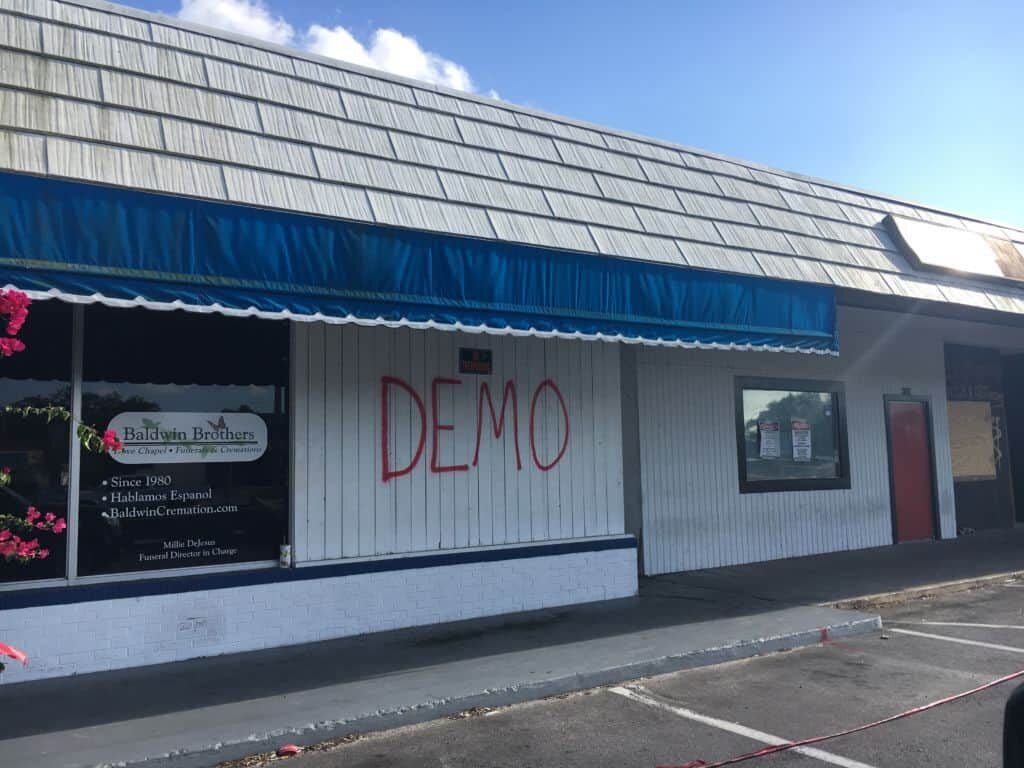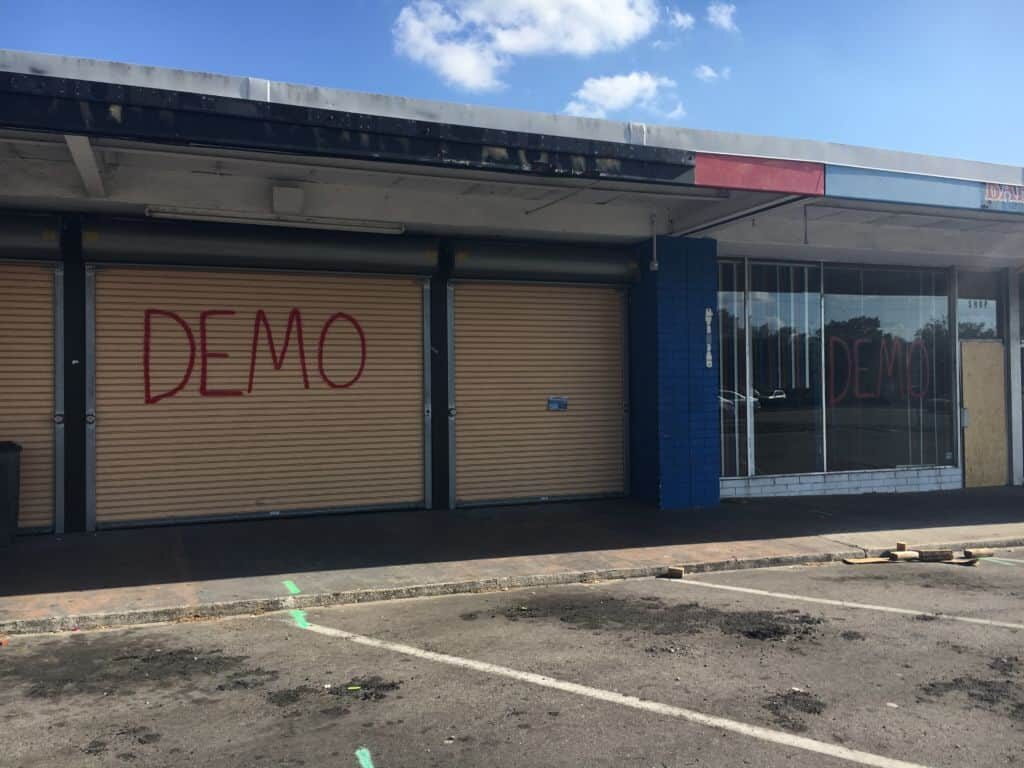In recent years, I've written two blog posts about the sad (and full preventable!) scenarios where the wrong building was demolished by a crew.
In these scenarios, it's easy to blame “bad crew” instead of looking at systemic causes of such an error. Having a better process is always more effective than admonishing people to “be more careful.”
From 2010:
Should Have Posted a “Caution: Don't Knock Our House Down” Sign?
And from 2016:
#Throwback Thursday: Wrong House Gets Demolished (And It Happened Again)
It's clearly not practical to write NO!!!! on every home or building that is to not be demolished.
That's why this scene caught my eye when driving in Orlando recently… a shopping center is apparently going to be demolished in the near future:
If a demolition crew were to show up at the wrong shopping center… let's say the right street address on the wrong street, NOT seeing “DEMO” (or seeing businesses that are open instead of shuttered) would hopefully clue them in about their error.
This seems like a good practice:
- Somebody (demolition company manager?) marks the correct property
- Allow some time to pass (a day or a week?) to allow somebody to speak up if the property was marked in error
- Have the demolition crew show up and ONLY knock down buildings marked “DEMO”
That would create a bit of delay in the demolition “value stream,” but I'd hope demolitions are planned and scheduled anyway. Do it right the first time, eh?
Demolish it right the first time… or demolish the right place the first time.
A few days later, my Lyft driver was taking me past that spot on the way to the airport and I saw the buildings. The Lyft driver had asked about what work I do and, as we were talking about improving healthcare (safety, quality, efficiency, waiting times, cost, employee environment… all of those interconnected goals), I pointed out the buildings and “DEMO.”
He was dumbfounded that the wrong building could ever be knocked down. I asked him, “How often do you think the wrong surgery gets performed on the wrong patient?” That was less funny to him.
Wrong site or wrong side surgeries are supposed “never events” that still happen too often.

Some reading on this topic (surgery, not building demolition errors):
- Wrong-Site, Wrong-Procedure, and Wrong-Patient Surgery
- Wrong-Site Surgery Cited as Top OR Safety Challenge Among U.S. Hospitals, Survey Finds
The causes of wrong site demolition or wrong site surgery are probably similar…
- poor communication
- people being rushed and under pressure
- a “just get it done now” mindset
- bad processes
- a lack of error proofing
- not pointing out near misses in a way that could lead to fixing the process to prevent future mishaps
- etc
How could these concepts be applied in your hospital or your workplace? Where do you see “dumb mistakes” being made? How can we prevent them, since people aren't dumb?
What do you think? Please scroll down (or click) to post a comment. Or please share the post with your thoughts on LinkedIn – and follow me or connect with me there.
Did you like this post? Make sure you don't miss a post or podcast — Subscribe to get notified about posts via email daily or weekly.
Check out my latest book, The Mistakes That Make Us: Cultivating a Culture of Learning and Innovation:












Why is there any surprise or shock when wrong site surgery or any medical errors are discussed for that matter? I think wrong site surgery and medical errors in general should be discussed not to name, shame, and blame, but to grow awareness of the facts and start looking at system, organization, and governance improvements. I was shocked to discover that 30 percent – 40 percent of that care is waste and is presumed to be a cause to rising costs.
In my experience, the shock comes from people being surprised these errors occur. They aren’t blaming or shaming (nor am I trying to do that). The general public is very unaware of the risks of error in healthcare. Everybody puts way too much trust and faith in the healthcare system.
I agree people do put a lot of trust and faith in the healthcare system. Getting back to the post. I wonder if these demo companies use checklists like construction, aviation, healthcare, and others are using to avert risks of wrong site demolition. It can address many of the causes you list. Maybe demo companies can learn from construction companies how to use checklists as outlined in “The Checklist Manifesto.” Just a thought…”Man is fallible, but maybe men are less so.” -Gawande
I’d hope they use checklists.
My concern is that there’s still risk of assumption or other cognitive error.
The checklist asks, “Confirm this is the right house.”
Yup, it’s right, they think.
But they’re confirming their knowledge of something that’s erroneous. That’s why I’d prefer more active error proofing than a checklist.
Is it possible that somebody marks the wrong house? Sure. What can you do to build in prevention or detection into the process?
Hi Mark,
I loved your Be More Careful website. I’d love to see you bring some of the posts to the blog and see if you can get people to recommend error-proofing solutions for all of those various “Be Careful” images. While I can think of some solutions, some of my ideas seem potentially too costly and I’m curious if the Lean Blog community has less expensive solutions. One possible recommendation for the baseball outfield warning track would be to make any ball caught on the warning track an automatic home run. This would take away the incentive to keep trying to catch the ball once the player steps on the warning track. Of course, this would only work if the players were conscious of when they were on the warning track, but simply not motivated to stop. And yes, I know, this would radically change the ease with which home runs are made, so I think the proposals you made in the leanblitz blog post about moving the scoreboard or adding more padding are probably better. I’m just brainstorming
That’s a good idea to brainstorm some solutions. When safety is at risk, I’d think nearly any solution would be less expensive than the cost of an injury or death. Or, we can put “creativity over capital,” as Lean thinking teaches us to do.